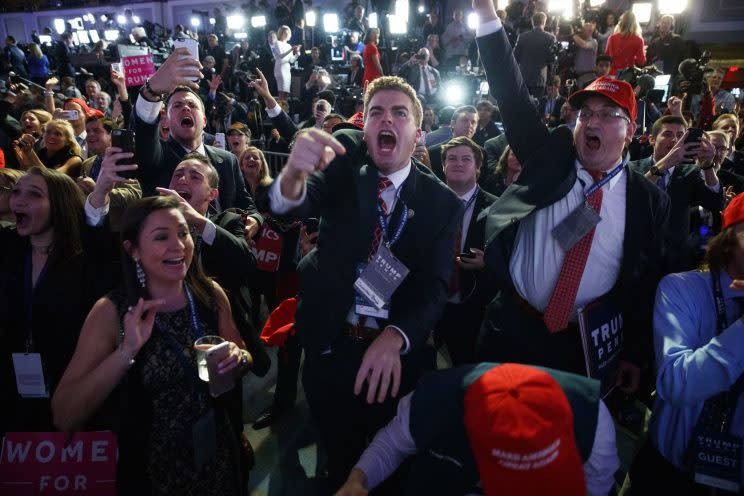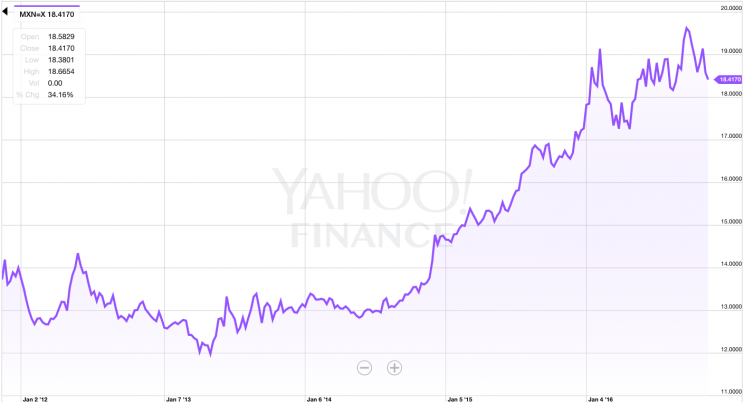AS IT HAPPENED: Donald Trump wins the White House and markets go haywire
Donald Trump has been elected the 45th president of the United States.
Trump’s win came as a shock to investors and sent markets into a tailspin through the night on Tuesday and into the pre-dawn hours of Wednesday.

The market’s nadir came at 11:55 p.m. ET, when the S&P 500 went limit-down after a 5% decline, meaning trading below this level would be halted until Wednesday morning.
Near 2:30 a.m. ET, when the Associated Press called the election for Trump, Dow futures were down about 520 points and S&P 500 futures were off 3.4%.

As it happened
At 2:31 a.m. ET on November 9, 2016, the Associated Press called the election for Donald Trump.
Following this call, the market reaction was fairly muted and Dow futures sat about 300 points off their worst levels of the evening.
At 1:40 a.m. ET, shortly after the AP called for Trump to win Pennsylvania in a move that very-nearly sealed the election, stocks were off their worst levels with Dow futures down 660 points, or 3.6%, S&P 500 futures were down about 91 points, or 4.3%, and Nasdaq futures were down 229 points, or 4.8%.
At 11:55 p.m. ET, stocks hit their nadir, as we had S&P 500 futures falling 5%, hitting limit-down and halting trading below this level until the next morning.
The last time we saw stocks decline like this was following the surprise Brexit vote back in June. Around that time Dow futures were also down over 800 points, or 4.5%, while Nasdaq futures were off 5%, or 243 points. Nasdaq futures also went limit-down.
The Mexican peso also got crushed, falling as much as 13% against the US dollar to as low as 20.71 after having rallied to as high as 18.16 earlier in the evening. The peso has largely tracked the fortunes of Hillary Clinton throughout the campaign and that story is not changing on election night.
As of around 1:40 a.m., the peso had recovered some losses and was off about 10% against the US dollar. A Reuters poll released last week indicated currency strategists saw potential for a 10% slide in the peso’s value were Trump to win.
Gold prices were also rocketing higher, rising as much as 3.8% to above $1,320 an ounce. Gold is often viewed as a “safe haven” trade and would be expected to move inversely with stocks.
US Treasury bonds, which are also viewed as a safe haven asset, were rallying with the 10-year yield down to 1.74% from 1.89% earlier, while the 2-year yield was down to 0.73% from 0.88%.
Markets in Asia also took it on the chin with the Nikkei in Japan falling nearly 1,000 points, or more than 5%, while the Hang Seng in China fell 3%, stocks in Australia were off about 2%, and stocks in India lost 3%.
Throughout the night, however, markets were ahead of the election results, pricing in a Trump victory hours before the news became official.
The peso said it all
The peso had moved in lock-step with Clinton’s fortunes throughout the campaign. And that story is did not change on election night.

A Trump victory had been seen as negative for the peso given Trump’s indications that he could pursue more restrictive trade policies.
Additionally, Trump has declared throughout the election that he would build a wall along the US-Mexico border and that Mexico would pay for it.
The peso had lost considerable value against the dollar — sliding from around 13 pesos per dollar to around 19 — over the last couple years amid a broad sell-off in emerging-market currencies.
Tuesday’s more than 10% decline was the peso’s worst day in decades.

Any reaction might be short-lived
In a note to clients on Monday, David Zervos, a strategist at Jefferies, cautioned that market action we see into, during, and after election results on Tuesday is likely to prove short-lived.
“I want to point out that knee-jerk market reactions to political events should be treated with a high degree of skepticism,” Zervos writes. “The Brexit example is a clear warning on that front.
“That said, the initial market response to either a Clinton or a Trump victory seems well enshrined in the price action via our two recent FBI tape bombs. For Clinton it’s spoos up, curve flatter and DXY up — while for Trump it’s the opposite. The magnitudes of course depend on embedded expectations, so as either candidate’s likelihood rises in the polls, their associated market moves on a win will fade in significance.”
This market reaction is more or less what played out.
History says…
A common disclaimer you hear around investing advice is that past performance does not guarantee future returns.
This is true.
But what is also true is that market patterns tend to repeat over time, and over a century of market data makes clear that stocks have done better with Democrats in the White House than Republicans.
Via Bespoke Investment Group, here’s a handy chart outlining returns for the Dow under a variety of White House and Congress scenarios. Highlighted in gray are the two most likely outcomes of Tuesday’s vote. Both have, historically, been good for stocks.
Tuesday’s outcome of Republicans controlling both the executive and legislative branches of the government has also been fruitful for markets, with the Dow logging an 8% annualized return during these instances.

What’s next
The markets gave their own version of events on Tuesday night, but what happens after the headline results are in, the initial market moves are made, and investors have to contend with the reality of a Trump or Clinton administration?
Fortunately, Yahoo Finance has you covered to answer all your questions about where we go from here.
Rick Newman has the details on how Trump and Clinton differ on immigration, infrastructure, Social Security, taxes, and jobs.
Nicole Sinclair has the skinny on what the election means for stocks, bonds, currencies, and commodities.
—
Myles Udland is a writer at Yahoo Finance.
Read more from Myles here; follow him on Twitter @MylesUdland
